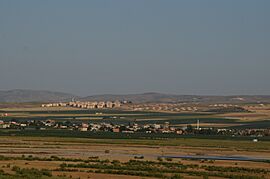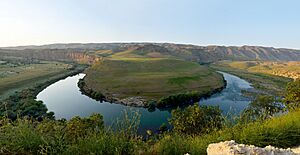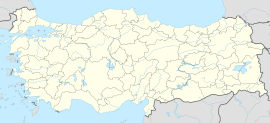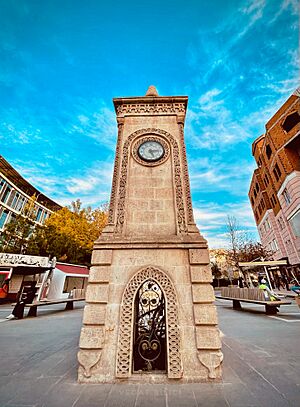Batman, Turkey facts for kids
Quick facts for kids
Batman
|
|
|---|---|
 |
|
| Country | Turkey |
| Province | Batman |
| District | Batman |
| Population
(2021)
|
452,157 |
| Time zone | TRT (UTC+3) |
Batman (also known as Êlih in Kurdish) is a city in Turkey. It is the capital of Batman Province. The city sits on a flat area about 540 meters (1,772 feet) above sea level. It is located near where the Batman River meets the Tigris river. In 2021, about 452,157 people lived there. Most of the people in Batman are Kurds.
The Batı Raman oil field, Turkey's largest oil field, is just outside the city. Batman also has a local airport and a military airbase. This airbase was used to help with search and rescue during the Gulf War.
Until the 1950s, Batman was a small village with only about 3,000 people. But in the 1940s, oil was found nearby. This led to fast growth, and many people moved to the area for work. In 1957, the village was renamed Batman, after the nearby river. It became a city and an important district center. Over the next 50 years, many of Batman's one-story buildings were replaced with taller ones. This caused the population to grow a lot. In 1967, a 511-kilometer (318-mile) oil pipeline was built. It carries crude oil from the Tüpraş Batman Oil Refinery to the port city of Dörtyol on the Mediterranean Sea. In 1990, Batman became the capital of its own province.
Besides oil, which is very important to the region, Batman also makes other products. These include drinks, processed food, chemicals, furniture, shoes, machines, and transportation equipment. A university, Batman University, was started in the city in 2007. It is part of the Erasmus Programme, which helps students study abroad.
Contents
History of Batman City
Ancient Times in Batman Province
The area around Batman has been home to people for a very long time. This is because of the important Tigris River and its rich lands. There are also rocky hills with many caves that offered natural shelter. Evidence from archaeology suggests people lived here since prehistoric times.
The first written records of settlements in the province are from the 7th century BC. An artificial "island" was built in this marshy area. It was called elekhan and was independent for 194 years. This lasted until Alexander the Great invaded in 352 BC.
The Batman Province was an important religious center from the 4th to 6th centuries AD. It was part of the Byzantine Empire for seven centuries. In the 11th and 12th centuries, it came under the control of the Great Seljuq Empire and Artuqids. It became a key stop on the Silk Road.
This area was once home to many different groups of people. These included Syriac Christians, Pontic Greeks, Assyrians, Baghdadi Jews, and Armenians. These groups lived in the region from 500 BC until the late 1800s. In 1515, Mahmoud Pasha Elekhani brought big changes to how the area was managed and what language was used. It is thought that a version of his name, Elah, became Iluh. This was the old name for the city of Batman.
Modern History of Batman City
In 1957, the area became the capital of a district in the Siirt Province. Then, in May 1990, the Batman Province was created, and the city became its capital. A railway line connected Batman with Istanbul in 1944. This was the main way to travel until the 1950s, when highways became more important.
Before the 1950s, Batman was a village of about 3,000 people. It was called Iluh and was part of the Siirt Province. It was first located in the Elmedin district of Siirt. This entire district disappeared in early 1926 due to a flood from the Batman River. After that, Iluh became part of the Beşiri sub-province. On September 2, 1957, the village became a district center. It was renamed Batman after the nearby river, which had been known by that name since at least the 1800s. On May 16, 1990, it was made the capital of the Batman Province.
This change in administration shows how fast the city grew because of its oil industry. Oil was found in the region in the 1930s. Turkey's oldest oil refinery was built in Batman in 1955. It processes crude oil from the Raman and Garzan areas. The refinery is run by Tüpraş. It can process 1.1 million tonnes of oil each year.
The growth of oil fields outside the city led to Batman's rapid development starting in the 1950s. Because of this, the city was called a "Priority Region for Development." A high school was built in the city in 1975. Most one-story houses were rebuilt into multi-story buildings. However, many people came to work in the oil industry, which led to many small, unauthorized buildings being built on the edge of the city. Most industrial areas were placed in the southern and southeastern parts of the city due to wind direction.
Population of Batman
The population of Batman has been growing quickly. Between 1990 and 2000, it grew by 5% each year. By 2008, the population reached 298,342. There were slightly more males than females. In 2000, about half of the people were married, and families had about 5 children on average. About 5 people usually lived together in one house. The main language spoken in the city is Kurdish.
Industries in Batman
Batman's main product is oil. There are many oil fields nearby. These oil fields have led to the building of many pipelines. These pipelines move oil to and from important cities. Besides oil, Batman also produces drinks, processed food, chemicals, furniture, shoes, machines, and transportation equipment.
Oil Fields in the Region
The search for oil in the Batman Province began in 1935. On April 20, 1940, oil was found 1,048 meters (3,438 feet) deep at the Raman oil field. This field is southeast of Batman. The first test well started producing 10 tonnes (about 62 barrels) of oil per day on June 6, 1940. The field was supposed to start commercial production by 1945. However, it was delayed until 1947 because there was not enough storage. To fix this, a small refinery was built at the site in 1947. It could process 9 tonnes of oil per day. In November 1948, a larger refinery was finished in Batman. It could process up to 200 tonnes per day. An even bigger refinery (330 tonnes per day) was completed in Batman in 1955. Several other oil fields were found later around Batman. The largest is the Batı Raman oil field, which produces about 7,000 barrels of oil daily.
Oil Pipelines
A 511-kilometer (318-mile) oil pipeline was built in 1967. It goes from Batman to Dörtyol, a port city on the Mediterranean Sea. This pipeline carries crude oil from the Batman region. It can carry 3.5 million tonnes of oil each year. In the 1990s, it transported about 20 million barrels (about 2.7 million tonnes) of oil. Between 2003 and 2007, it carried about half that amount.
Another shorter pipeline, 41 kilometers (25 miles) long, connects Batman with Şelmo. Şelmo is where Turkey's second-largest oil field is located. This pipeline transferred between 1.5 million and 0.5 million barrels of oil per year from 1990 to 2007. Both pipelines are operated by BOTAŞ.
Education and Sports in Batman
Education
According to the 2000 census, 15% of males and 43% of females in Batman could not read or write. Among those who could read and write, about 33% of males and 29% of females had not finished secondary school. About 3.3% of males and 0.9% of females had a university education. Around 13% of males and 3.8% of females had finished high school or an equivalent program. Batman has 71 elementary schools and 12 high schools.
Batman University
The city also has a university, Batman University, which opened on May 27, 2007. It has about 140 staff members. The university has faculties for Science and Letters, Technical Education, and Engineering. These mostly teach subjects like engineering, business, and administration. About 2,500 students from different parts of Turkey study at the university. It is part of the Erasmus Programme, which is a student exchange program.
Sports
Association football (soccer) is the most popular sport in Batman. The city has a professional football club called Batman Petrolspor. It was formed in 1960 and plays in the third division, the TFF Third League. The club was named after the city's oil industry. Another local football team, 72 Batmanspor, plays in the Amateur League. Batman has a football stadium that can hold 4,900 spectators.
Another popular sport is wrestling. Freestyle wrestlers from Batman have won national competitions. Ali Riza Alan won a gold medal in 1970 and a silver medal in 1974 in world championships. He competed in the weight category under 52 kg (115 lb).
Batman's main sports venue is Atatürk Sports Hall. It can hold 1,000 spectators. This hall supports many sports and activities. These include badminton, basketball, gymnastics, wrestling, folk dance, handball, and martial arts. Martial arts include kurash, judo, aikido, wushu, karate, and taekwondo. Other sports are table tennis, volleyball, and swimming.
Getting Around Batman
Batman is connected by highways and railways to nearby cities like Diyarbakır and Kurtalan, and to the capital city, Ankara. The distance by highway to Istanbul is about 1,465 km (910 mi). To Ankara, it is about 1,012 km (629 mi), and to İzmir, it is about 1,520 km (944 mi).
There is also a regional airport just outside Batman. It offers direct flights to İzmir, Ankara, and Istanbul. The airport is also a military base called Batman Air Base. This base was updated in 1982 after an agreement between the US and Turkey. This allowed US tactical aircraft to use the base as part of NATO forces. It helped them patrol the Caucasus, Turkey, and Iran without needing to refuel. The base was later used to deliver aid and for rescue missions in Iraq during the 1991 Gulf War.
Geography of Batman

Batman is built on a flat area about 540 meters (1,772 feet) above sea level. However, there is a slight downward slope of up to 0.6 degrees in the northeastern and southern parts. There are almost no forests in or around the city. The Iluh River, which flows into the Batman River, runs through the city.
The soil in Batman is mostly soft and porous clay. This soil is not very stable and can be easily washed away by rain and floods from the Batman and Iluh rivers. Floods usually happen between March and May, but sometimes they occur between October and November. Major floods have happened in the past. For example, in April 1969, 60 buildings were damaged. In April and May 1972, 210 buildings were damaged. In November 1991, 500 buildings were flooded. In March 1995, nearly 1,000 buildings were underwater and 450 were damaged. In October 2006, 11 people died and 20 were injured due to floods.
Climate in Batman
Batman has a hot summer Mediterranean climate. This means summers are very hot and dry. On average, July temperatures are around 30.9°C (87.6°F), making it one of the hottest cities in Turkey. There is almost no rain during the summer months.
Winters are cool and wet, with cold nights. Snow falls sometimes between December and March, usually for a week or two. The most snow ever recorded was 32.0 cm (12.6 inches) deep.
The highest temperature ever recorded in Batman was 48.8°C (119.8°F) on July 10, 1962. The lowest temperature ever recorded was -24.0°C (-11.2°F) on January 1, 2007.
| Climate data for Batman (1991–2020, extremes 1959–2023) | |||||||||||||
|---|---|---|---|---|---|---|---|---|---|---|---|---|---|
| Month | Jan | Feb | Mar | Apr | May | Jun | Jul | Aug | Sep | Oct | Nov | Dec | Year |
| Record high °C (°F) | 18.6 (65.5) |
24.6 (76.3) |
30.6 (87.1) |
35.8 (96.4) |
42.0 (107.6) |
45.1 (113.2) |
48.8 (119.8) |
46.2 (115.2) |
43.8 (110.8) |
37.0 (98.6) |
28.6 (83.5) |
22.6 (72.7) |
48.8 (119.8) |
| Mean daily maximum °C (°F) | 8.0 (46.4) |
10.9 (51.6) |
16.2 (61.2) |
21.8 (71.2) |
27.8 (82.0) |
35.3 (95.5) |
39.7 (103.5) |
39.6 (103.3) |
34.5 (94.1) |
27.0 (80.6) |
17.0 (62.6) |
9.6 (49.3) |
23.9 (75.0) |
| Daily mean °C (°F) | 3.1 (37.6) |
5.1 (41.2) |
9.8 (49.6) |
14.6 (58.3) |
19.8 (67.6) |
26.7 (80.1) |
30.9 (87.6) |
30.4 (86.7) |
25.1 (77.2) |
18.4 (65.1) |
10.0 (50.0) |
4.6 (40.3) |
16.5 (61.7) |
| Mean daily minimum °C (°F) | −1.0 (30.2) |
0.2 (32.4) |
3.8 (38.8) |
7.8 (46.0) |
11.6 (52.9) |
16.4 (61.5) |
20.8 (69.4) |
20.4 (68.7) |
15.6 (60.1) |
10.8 (51.4) |
4.2 (39.6) |
0.5 (32.9) |
9.3 (48.7) |
| Record low °C (°F) | −24.0 (−11.2) |
−22.2 (−8.0) |
−17.0 (1.4) |
−9.0 (15.8) |
0.9 (33.6) |
0.0 (32.0) |
11.8 (53.2) |
11.5 (52.7) |
4.4 (39.9) |
−3.0 (26.6) |
−7.6 (18.3) |
−23.0 (−9.4) |
−24.0 (−11.2) |
| Average precipitation mm (inches) | 58.3 (2.30) |
67.9 (2.67) |
77.3 (3.04) |
71.3 (2.81) |
45.2 (1.78) |
9.1 (0.36) |
2.3 (0.09) |
2.6 (0.10) |
6.1 (0.24) |
36.1 (1.42) |
49.3 (1.94) |
67.8 (2.67) |
493.6 (19.43) |
| Average precipitation days | 10.17 | 10.13 | 11.43 | 11.03 | 8.3 | 2.03 | 0.53 | 0.30 | 1.13 | 5.73 | 6.37 | 10.23 | 77.4 |
| Average snowy days | 2.1 | 1.5 | 0.8 | 0 | 0 | 0 | 0 | 0 | 0 | 0 | 0.1 | 0.8 | 5.3 |
| Average relative humidity (%) | 77.4 | 71.9 | 66.1 | 64.8 | 57.7 | 39.0 | 32.2 | 31.8 | 36.9 | 51.5 | 68.5 | 78.1 | 56.1 |
| Mean monthly sunshine hours | 99.2 | 130.0 | 170.5 | 219.0 | 279.0 | 348.0 | 368.9 | 347.2 | 294.0 | 217.0 | 159.0 | 90.0 | 2,721.8 |
| Mean daily sunshine hours | 3.2 | 4.6 | 5.5 | 7.3 | 9.0 | 11.6 | 11.9 | 11.2 | 9.8 | 7.0 | 5.3 | 3.0 | 7.4 |
| Source 1: Turkish State Meteorological Service | |||||||||||||
| Source 2: NOAA (humidity, 1991–2020), Meteomanz(snow days 2008-2023) | |||||||||||||
Famous People from Batman
- Ali Rıza Alan – A world champion in freestyle wrestling (1970).
- İbrahim Bilgen – A Turkish politician.
- Hüseyin Kalkan
- Nalin Pekgul – A Swedish politician.
- Mehmet Şimşek – Former Minister of Finance of Turkey.
- Karapetê Xaço – An Armenian singer of traditional Kurdish dengbêj music.
See also
 In Spanish: Batman (Turquía) para niños
In Spanish: Batman (Turquía) para niños





